As previously shown in Figure 5, UN inter-agency pooled funds constituted 5% of total earmarked contributions to the UN system in 2023. Prior to that, total contributions doubled from US$ 1.7 billion in 2016 to a peak of US$ 3.4 billion in 2021, reflecting increased demand for pooled funding services in support of joint UN action on SDG implementation, along with the COVID-19 response, peacebuilding and climate action. However, contributions decreased to US$ 3.3 billion in 2022, and then to US$ 2.8 billion in 2023, as shifting geopolitical dynamics led to resources being redirected away from multilateral humanitarian and development assistance.
Funding composition for UN humanitarian assistance: Top Member State contributors and the EU, 2023 (US$ million)
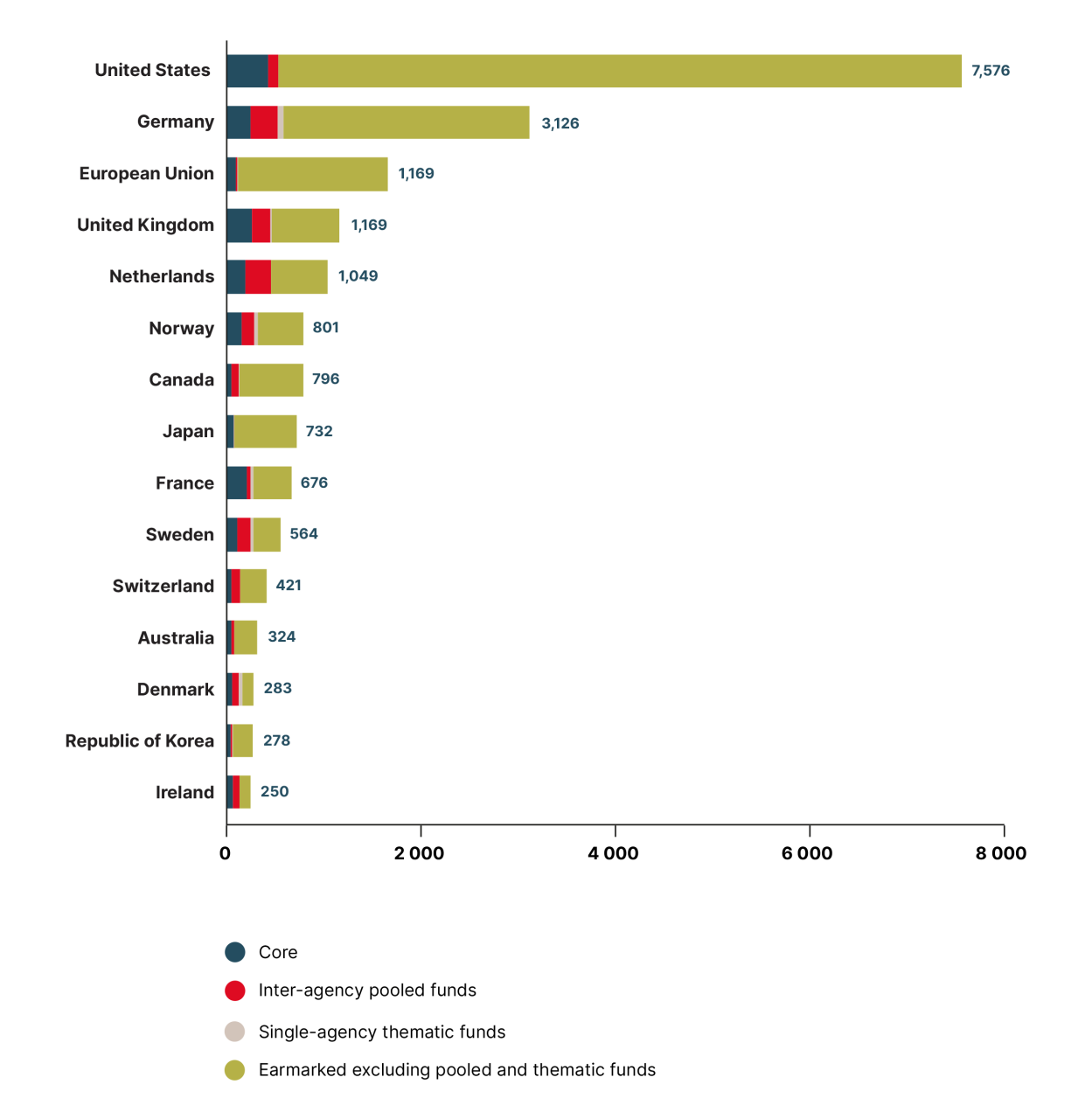
Source: Report of the Secretary-General (A/80/74-E/2025/53).
Figure 18 includes a line indicating the share of earmarked contributions for development activities provided by Member States through UN inter-agency pooled funds – one of the indicators established under the 2024 Funding Compact.37 In 2023, it stood at 11.1%, against a 2027 target of 30%. In 2023, according to the definition provided by the 2019 Funding Compact indicator, the total volume of earmarked contributions for development-related activities channelled through UN inter-agency pooled funds amounted to US$ 1.1 billion, or 8.1% of total earmarked contributions for development assistance, of which US$ 914 million (6.8%) were provided by Member States and US$ 168 million (1.3%) by the EU and non-government donors. This highlights the importance of broadening donor engagement and reinforcing multilateral funding commitments to meet future targets.
Contributions to UN Inter-agency pooled funds, 2016–2023 (US$ billion)
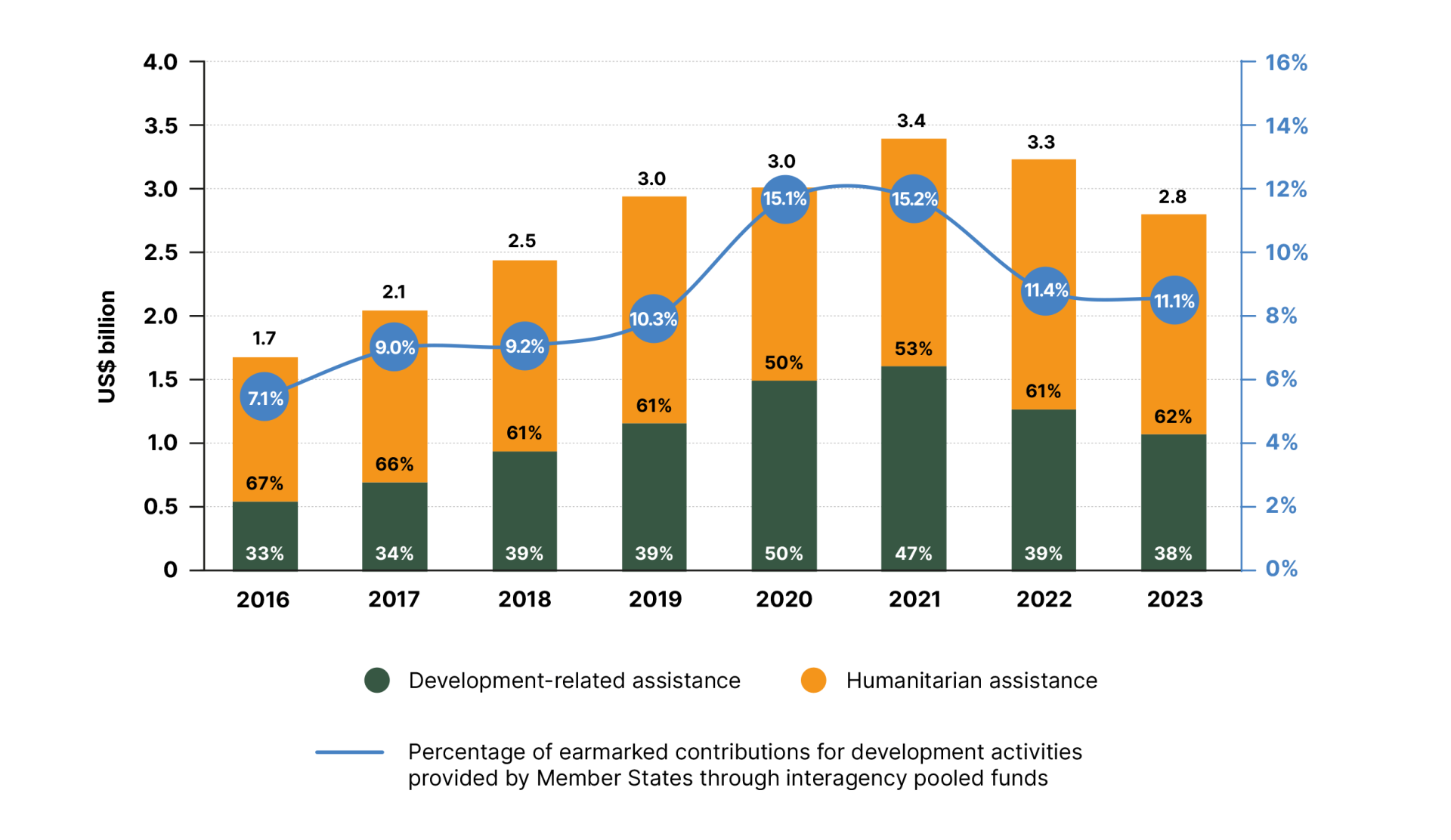
Source: Report of the Secretary-General (A/80/74-E/2025/53) and UN Pooled Funds Database. Historical data from various reports.
The downward trend in contributions to UN inter-agency pooled funds since 2021 has been more pronounced for development-related pooled funds than for humanitarian ones. The two panels of Figure 19 present a breakdown of contributions by geographic scope from 2016 to 2023, disaggregated into development-related and humanitarian pooled funds. Panel A shows that funding for development-related pooled funds rose from US$ 551 million in 2016 to a high of US$ 1.6 billion in 2021, before declining to US$ 1.1 billion in 2023. Breaking down the 2023 total, 48% of contributions supported global funds, 13% regional funds, and 39% country-level pooled funds.
Contributions for humanitarian pooled funds, illustrated in Pannel B, increased from US$ 1.1 billion in 2016 to a peak of US$ 2.0 billion in 2022, then fell to US$ 1.7 billion in 2023. Of this total, 32% supported CERF38 and 2% the Regional Humanitarian Pooled Fund for West and Central Africa (RHPFWCA),39 while the remaining 66% was allocated to country-based pooled funds (CBPFs).40
The portfolio of development-related global funds includes flagship initiatives such as the Peacebuilding Fund and the Joint SDG Fund, as well as pooled mechanisms supporting joint UN action on cross-cutting issues, including gender- based violence, migration, disability inclusion, antimicrobial resistance, the rights of marginalised groups, and forest protection. At the country level, development-related multi-stakeholder collaboration enables diverse partnerships to align under a common results framework, supporting implementation of national development plans and facilitating programmatic funding across various priorities. When used to finance a UNSDCF, inter-agency pooled funds serve as ‘core-like’ resources, offering the flexibility needed to support a broader results framework while adapting to evolving national needs.
Contributions to UN inter-agency pooled funds by geographic scope, 2016–2023 (US$ billion)

Source: UN Pooled Funds Database.
Funding of UN inter-agency pooled funds is highly concentrated among just a few partners. As Figure 20 reveals, the 15 top contributors in 2023 were responsible for 80% of these contributions. Germany, the top contributor, provided US$ 407 million across all fund categories, of which more than 25% went to CERF (US$ 107 million). The next two countries, the Netherlands and the United Kingdom, provided US$ 345 million and US$ 304 million respectively. Combined, these three donors accounted for over a third of UN inter-agency pooled funding received in 2023, reflecting their leadership in advancing flexible, collaborative financing.
The UN Secretary-General’s Peacebuilding Fund (PBF), administered by the Multi-Partner Trust Fund Office (MPTF Office), stands out within the peace and transition category as the UN’s primary financial instrument for addressing and preventing violent conflict. In 2023, it received US$ 161 million in contributions, which equates to 39% of the UN inter-agency peace and transition portfolio. The PBF encompasses a broad range of partners and represents a concerted international effort to support joint UN responses to critical peacebuilding opportunities. It is guided by the principles of timeliness, catalytic impact and risk tolerance, and has at its core a strong commitment to national ownership and integrated approaches.
Contributions to UN inter-agency pooled funds: Top contributors, 2023 (US$ million)
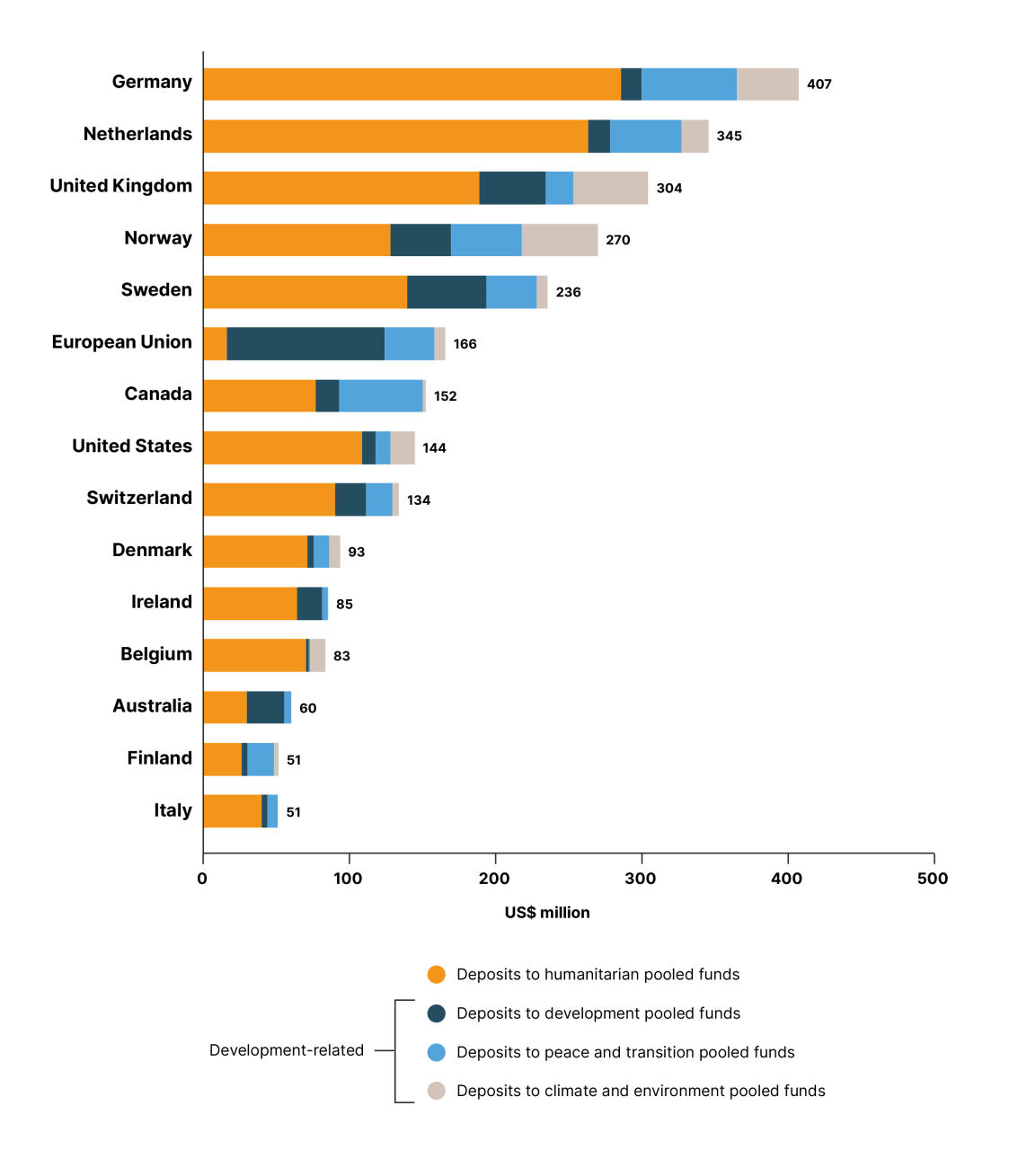
Source: UN Pooled Funds Database.
Equally significant is the growing role of climate and environment pooled funds within the development-related category. These funds respond to the UN Common Agenda’s call for action on the ‘triple crisis’ of climate change, biodiversity loss and pollution. The portfolio has evolved from early forest-focused initiatives, such as the UN-REDD Programme and the Central African Forest Initiative (CAFI), into a broader range of funds supporting biodiversity and marine ecosystems. These include the Cali Fund, the Global Fund for Coral Reefs, the Systematic Observation Financing Facility (SOFF), the Nature4Health Fund, and the Infrastructure Resilience Accelerator Fund (IRAF), all of which are actively leveraging new climate and environment partnerships for transformative change.41
Whereas Figure 20 highlights the top donors’ total contributions in absolute terms, reflecting volume-based leadership, Figure 21 showcases Member States with a more than 10% share of earmarked contributions for develop ment activities channelled through UN inter-agency pooled funds. As previously noted, the 2024 Funding Compact commits Member States to providing 30% of non-core contributions for development activities through UN inter-agency pooled funds by 2027. Four Member States have already fulfilled this commitment according to 2023 figures: Finland, Lithuania, Ireland and Norway. Meanwhile, Liechtenstein, the United Kingdom, Netherlands and New Zealand have all surpassed the 25% mark.
Countries contributing more than 10% of their earmarked funding to UN development assistance through UN inter-agency pooled funds, 2023
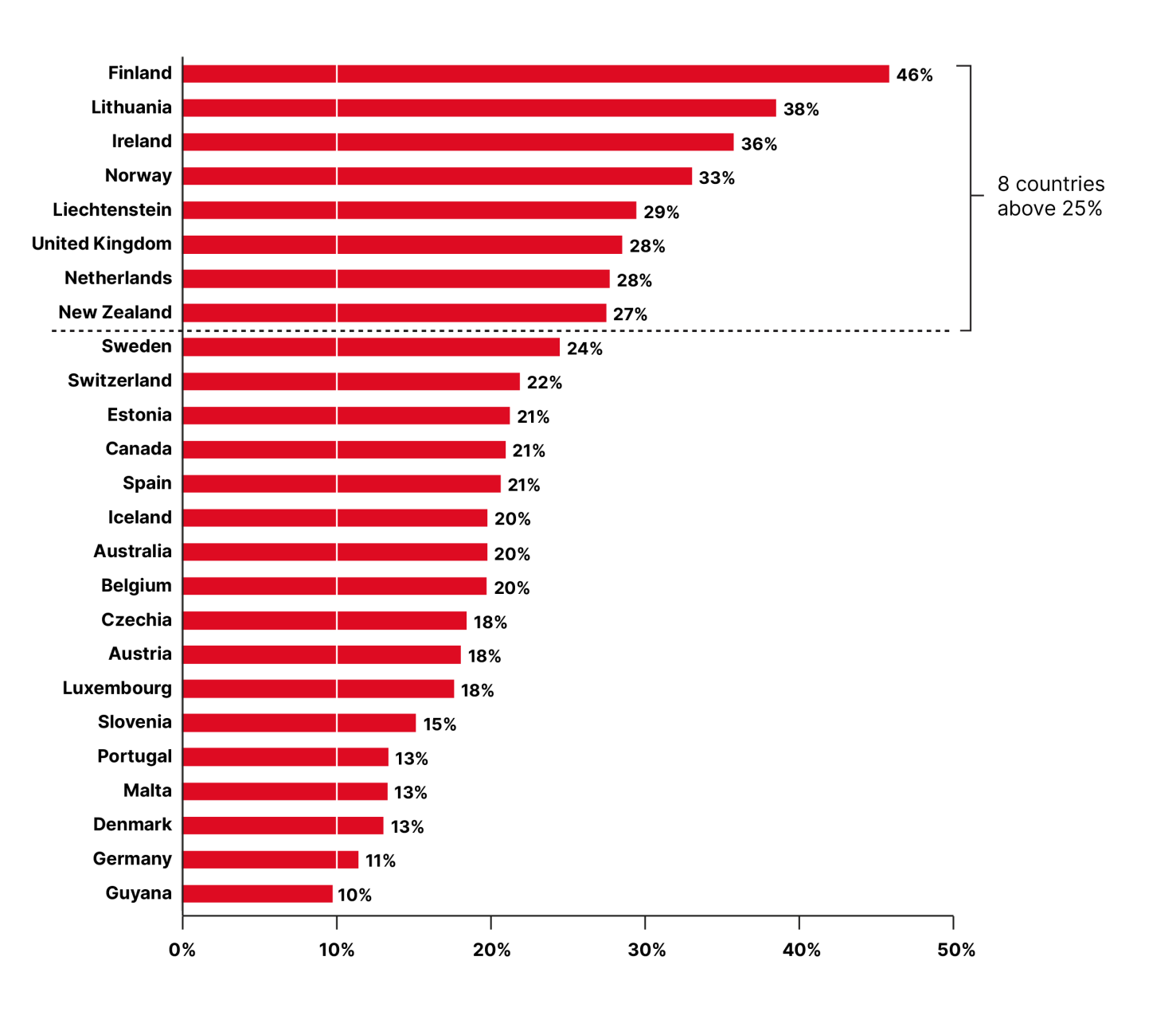
Source: Report of the Secretary-General (A/80/74-E/2025/53) and UN Pooled Funds Database.
Turning to resources transferred from UN inter-agency pooled funds for project/programme implementation, Figure 22 presents the top UN entities receiving such funding, disaggregated by thematic area. Panel A illustrates the transfers made in 2023, while Panel B shows cumulative values for the period between 2016 – when SDG implementation began – and 2023.
UNICEF was the top recipient of UN inter-agency pooled funds in 2023, having been allocated US$ 320 million, 62% of which came from humanitarian pooled funds. WFP was second, with US$ 274 million, the majority of which (83%) was sourced from humanitarian-themed funds, in line with its core mandate. UNDP ranked third, having received US$ 235 million. Looking at the cumulative values for the 2016–2023 period, UNDP was the largest overall recipient of UN inter-agency pooled funds, with $3.0 billion. Of this, 73% came from development-related funds, reflecting UNDP’s role in supporting the long-term development of UN programming countries.
The UN Secretariat ranked among the top three recipients of UN inter-agency pooled funding from 2016 to 2023, primarily due to OCHA’s partner role in channelling funding to NGOs under six humanitarian CBPFs administered by the MPTF Office (Afghanistan, Democratic Republic of the Congo, Central African Republic, Somalia, South Sudan, Sudan). In 2023, following a policy decision by the UN Emergency Relief Coordinator, administration of these six CBPFs was transferred from the MPTF Office to OCHA.
Top implementing UN entities receiving resources through UN inter-agency pooled funds, by fund thematic area
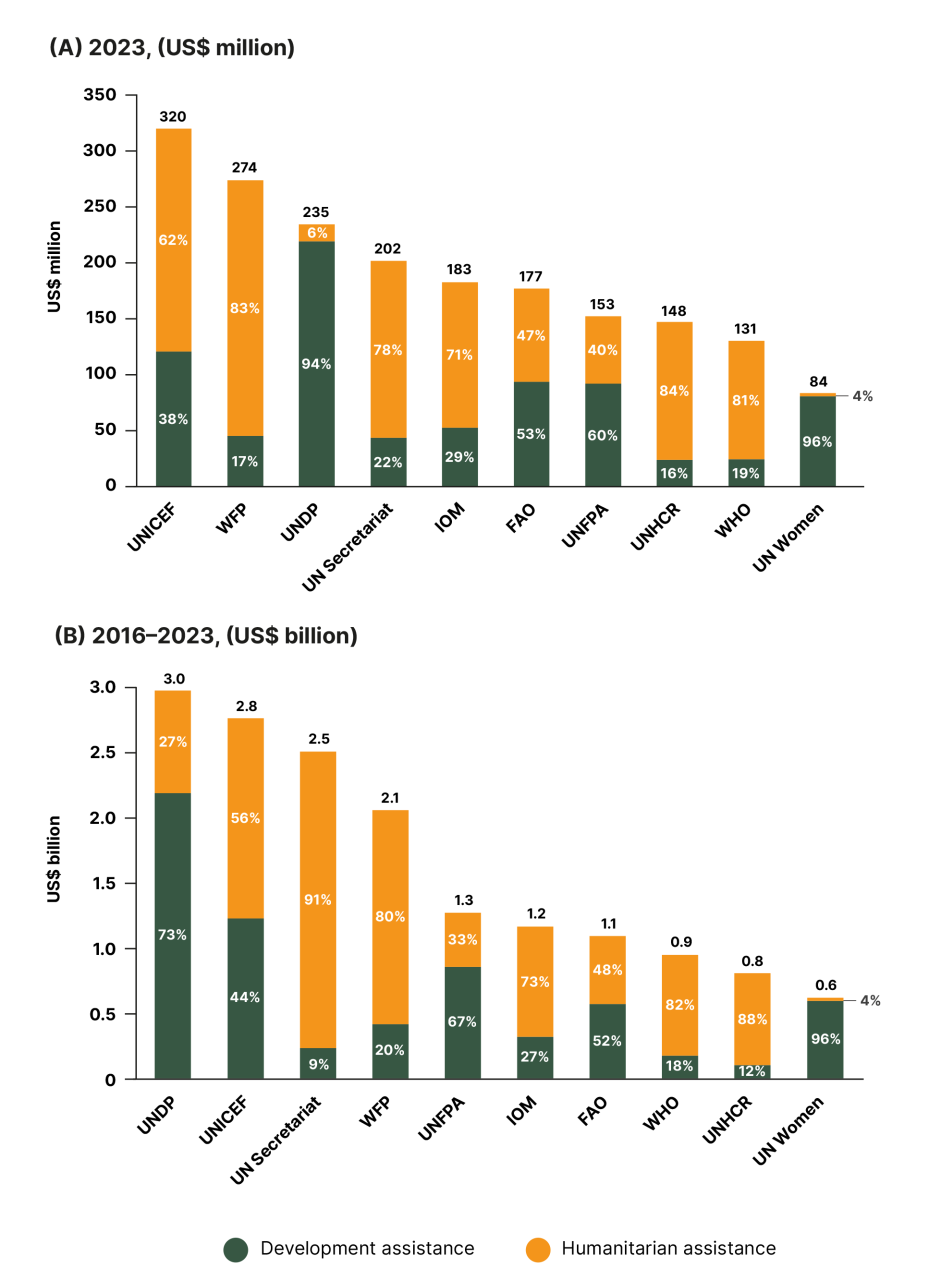
Source: UN Pooled Funds Database.
Figure 23 presents the top 15 countries or areas that received transfers from UN inter-agency pooled funds, disaggregated by thematic area. Afghanistan continues to be the country receiving the most funding from UN inter-agency pooled funds, predominantly from the Afghanistan Humanitarian Fund and CERF. Apart from Bangladesh, humanitarian pooled funds provided the greatest share when it came to recipient transfers, particularly so in the case of the following:42 Myanmar (97%); Ukraine (95%); the State of Palestine (94%); Ethiopia (93%); the Syrian Arab Republic (93%); and Sudan (91%). This pattern demonstrates the enabling role of UN inter-agency pooled funds in responding to protracted, complex crisis settings, as well as emerging ones.
Top UN inter-agency pooled funds recipient countries or areas, 2023 (US$ million)
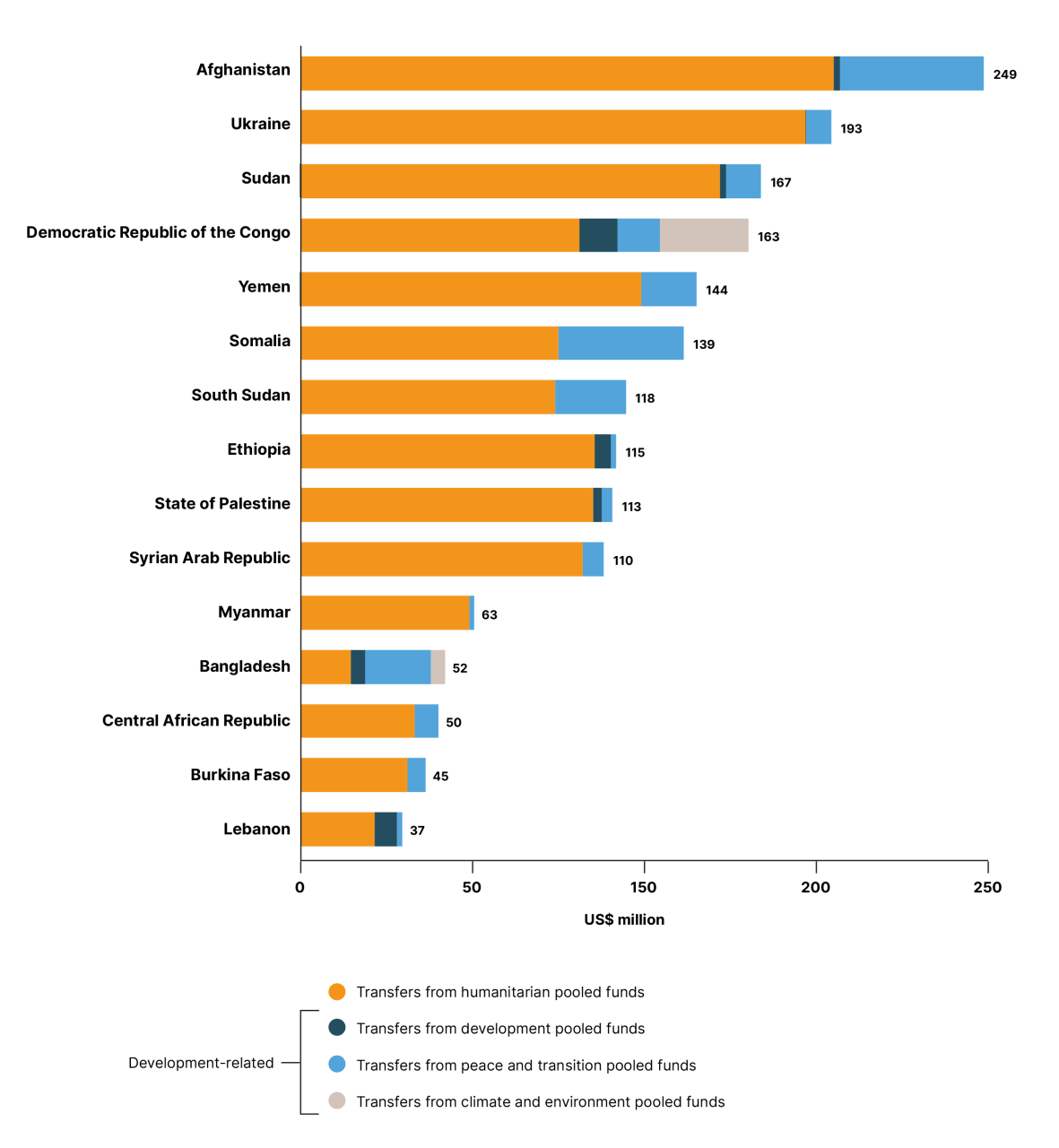
Source: UN Pooled Funds Database.
Figure 24 shows the countries or areas in which pooled funds accounted for 15% or more of earmarked development-related expenses. In doing so, it illustrates the strategic significance of UN inter-agency pooled funds for UN development-related activities. This is especially the case for lower-income countries, fragile countries and small island developing states (SIDS), where these resources support integrated, multi-stakeholder, priority-aligned programming of – among other things – UNSDCFs and national development plans. In 2023, 34 countries surpassed the 15% threshold, while a total of 54 countries received more than 10%. Despite the former figure remaining at the same level seen in 2022, it constitutes a significant increase on the 28 countries recorded in 2018.
A growing number of countries are benefitting from UN inter-agency pooled funds. Tokelau, Gabon and Equatorial Guinea stood out in 2023, with more than 70% of their UN earmarked development expenses channelled through UN inter-agency pooled funds.43 In Tokelau’s case, funding was provided through the Joint SDG Fund; for Gabon, primarily through CAFI; and for Equatorial Guinea, through the Equatorial Guinea MPTF. All three funds are administered by the MPTF Office.
Countries or areas where more than 15% of earmarked resources is channelled through development-related UN inter-agency pooled funds, 2023
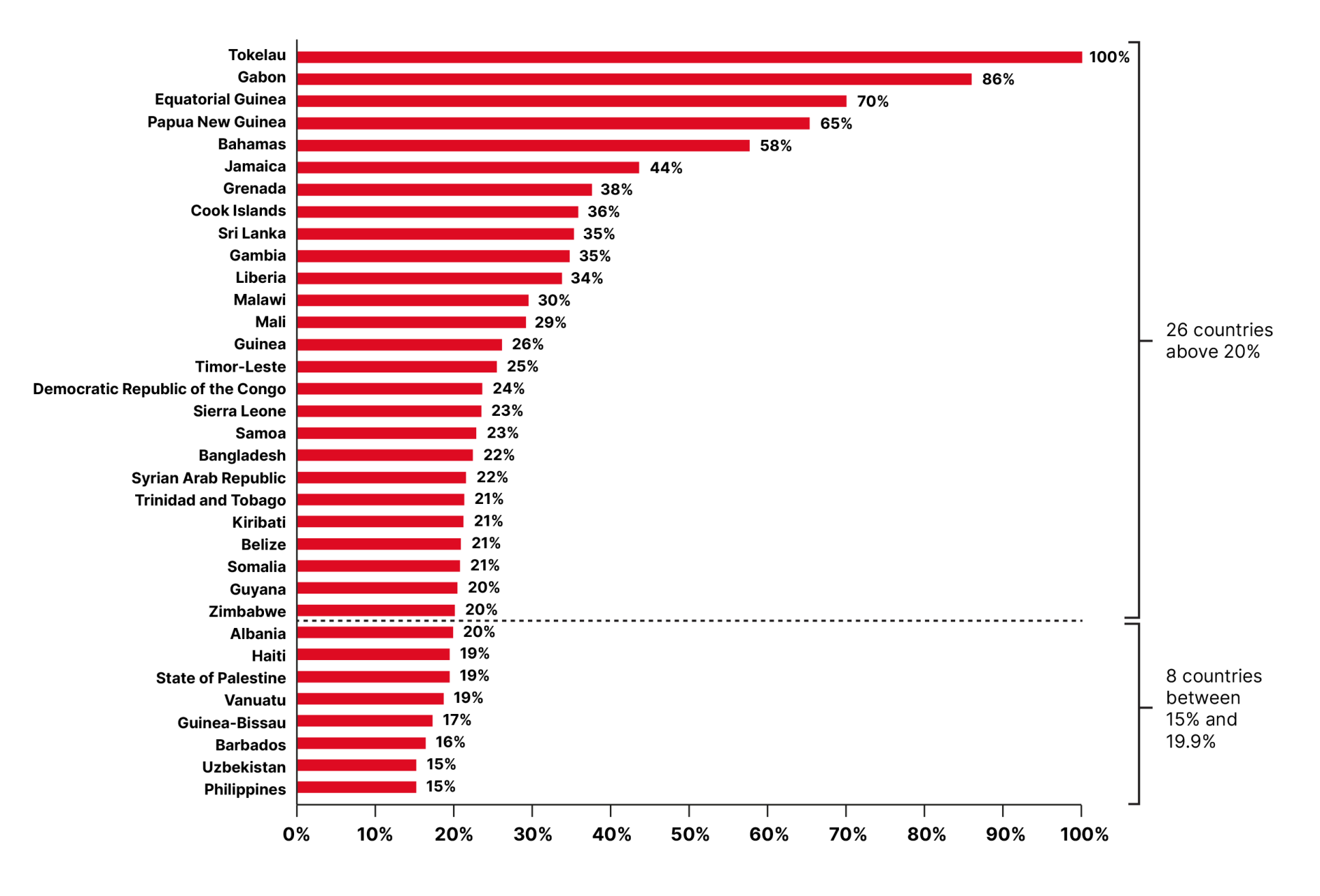
Source: Report of the Secretary-General (A/80/74-E/2025/53) and UN Pooled Funds Database.